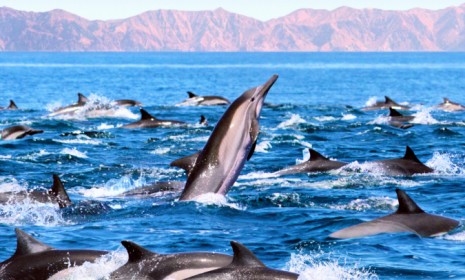7 surprising facts about dolphins
The friendly sea mammals can sniff out bombs, form complex networks, and eat dozens of pounds of fish a day

Dolphins are famously intelligent and gregarious creatures, which helps explain why humans are so fascinated by them. And now, new research suggests that the bottlenose dolphin's genetic makeup is actually much more human-like than scientists once thought. The findings are part of a growing canon of evidence bolstering the idea that the marine mammals are the second smartest of Earth's inhabitants. Here, seven recent revelations about dolphins:
1. Genetically, they're a lot like humans
Dolphins are at least as smart as apes, and can do many of the things apes can do, such as "mirror self-recognition, communication, mimicry, and cultural transmission," researcher Michael McGowen tells Discovery News. In fact, new research shows that dolphins' relatively large noggins can be explained by an evolutionary history that's remarkably similar to our own. After mapping 10,000 of the mammal's genes, McGowen and his colleagues discovered that dolphin minds evolved to allow for complex cognition just like humans' brains, as evidenced by a high metabolic rate that allows dolphin bodies to power large, energy-demanding brains.
The Week
Escape your echo chamber. Get the facts behind the news, plus analysis from multiple perspectives.

Sign up for The Week's Free Newsletters
From our morning news briefing to a weekly Good News Newsletter, get the best of The Week delivered directly to your inbox.
From our morning news briefing to a weekly Good News Newsletter, get the best of The Week delivered directly to your inbox.
2. They're gangsters
Dolphins are the gangsters of the sea, and have been observed patrolling small expanses of oceans in hierarchical pods. Each little swimming army comes with small subgroups assigned different tasks, such as protecting the group's females, recruiting other members to improve their ranks, or acting as peaceful liaisons to go out and communicate with rival pods. Sounds a lot like "the Mafia," says Virginia Morell at Wired.
3. They can sniff out bombs
Dolphins are the Navy's secret weapon for clearing underwater mines. They're employed in conflict areas like the Middle East's Strait of Hormuz, a key passageway for the world's oil tankers that's often dotted with bombs, thanks to mounting U.S.-Iran tensions. The military trains dolphins much in the way it trains bomb-sniffing dogs, teaching them how to spot hard-to-detect explosives and then mark them for the Navy's divers to disarm. There is, however, one downside to such a technique: The enemy can't tell a military dolphin from a wild one, so Iranian soldiers could indiscriminately attack all dolphins they see.
A free daily email with the biggest news stories of the day – and the best features from TheWeek.com
4. Dolphins have scary, hand-like penises
Male dolphins possess one of the stranger sex organs on the planet: A retractable penis used to navigate through the ocean, kind of like how humans use their hands to feel their way around. A dolphin's propensity to depend on his penis as a do-it-all multi-tool helps explain why the animals are known to "hump inanimate objects."
5. Killer whales are actually dolphins
It turns out Shamu and Flipper have more in common than you'd believe. Orcas, or killer whales, actually aren't whales at all, but are instead classified as the largest member of the dolphin family. That explains why the distinctive black-and-white animals are surprisingly intelligent as the "trainable stars of many aquarium shows," says National Geographic.
6. Dolphins are voracious eaters
An average-sized dolphin weighing in at 260 pounds eats roughly 33 pounds of fish per day. For an average-sized human, that's essentially the equivalent of eating 15 to 22 pounds of steak a day. And yet, the svelte dolphin doesn't gain any weight.
7. Dolphins are endearingly maternal
Until recently, dolphin births were largely a mystery. Then in 2007, at an enclosed pool in Italy, a photographer captured a few shots of a mother dolphin going into labor, only to see a baby emerge tail-first amidst a cloud of blood. "I was extremely lucky," says photographer Leandro Stanzani, who had been snapping shots of dolphins for 14 years. Shortly after giving birth, the mother was observed gently nestling her newborn calf to the surface for its first gulp of air, demonstrating that the widly complicated animals aren't just horny, mafia-like gangsters — they can be motherly, too.
Sources: Daily Mail, Discovery News, Facts.RandomHistory.com, National Geographic, Wired
-
 Zimbabwe’s driving crisis
Zimbabwe’s driving crisisUnder the Radar Southern African nation is experiencing a ‘public health disaster’ with one of the highest road fatality rates in the world
-
 The Mint’s 250th anniversary coins face a whitewashing controversy
The Mint’s 250th anniversary coins face a whitewashing controversyThe Explainer The designs omitted several notable moments for civil rights and women’s rights
-
 ‘If regulators nix the rail merger, supply chain inefficiency will persist’
‘If regulators nix the rail merger, supply chain inefficiency will persist’Instant Opinion Opinion, comment and editorials of the day